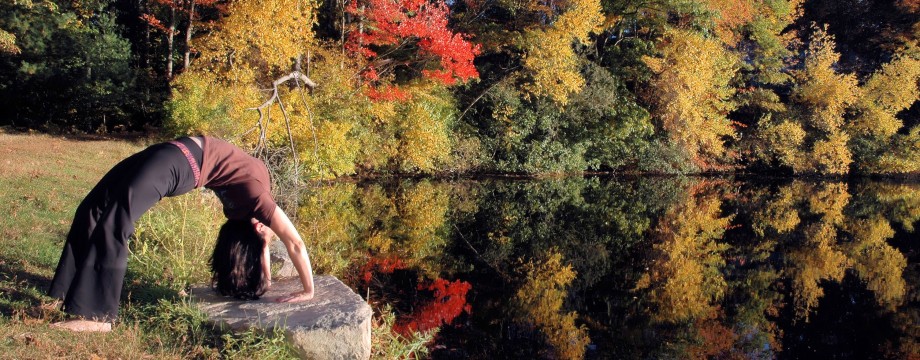If you teach yoga, you’re probably familiar with the phenomenon of the yoga audition. And if you don’t teach yoga, this may sound a bit disconcerting. But it’s a “thing” and yes, it flies in the face of what yoga is supposed to be all about in more ways than I have room to write about.
A friend of mine recently “auditioned” to teach yoga at a popular upscale fitness center in a major city. Her story is about as close as I’ll get to being a fly on the wall as I’ll never go to one of these cattle call auditions myself. She had three to five minutes to give it her best shot or rather, performance. She also had to participate as a student in everyone else’s auditions as well. This was part of the deal.
Am I alone in thinking that this is a messed-up way to find the most skilled yoga instructors? To that end, what other industry subjects job candidates to sit through other prospective employee interviews? But this is indicative of how upside-down the yoga industry has become. Pun intended.
I know a lot of professional actors and auditioning is a necessity if they want to land a role. But think about it: Yoga teaching is not acting, although it’s helpful to keep students engaged and entertained. It’s teaching.
What’s going on here? How did teaching yoga become another ego-filled offshoot of the entertainment industry?
I’m not just talking about the ludicrous way yoga teachers have to strut their stuff to land a teaching gig. I’m talking about the whole kit and caboodle. The entire yoga industry has run amuck and I’m not afraid to say so.
Let’s take a closer look at the general state of teaching yoga, keeping in mind this isn’t how we all roll:
- Yoga teachers are expected to work their way up to prime teaching slots at coveted studios. This means “volunteering” aka working at the reception desk, sweeping floors, cleaning up props and more. For free. If you’re a studio owner you may balk at this saying that your studio offers “work-study” – meaning your volunteer labor can take classes in exchange for work. This isn’t entirely awful, if you are made of money or perhaps a college student who wants to take a couple of classes a week as a hobby. But, barring those circumstances, if you’re aspiring to teach yoga, why not “volunteer” your services at a needy charitable organization versus a for-profit yoga studio? And to studio owners: I suggest paying wannabe teachers, even at minimum wage. This way they can decide how to spend their discretionary income.
A starting out yoga teacher is akin to a starving actor. It’s time the industry stops preying on these newbies.
- A skilled yoga teacher isn’t necessarily a marketing maven. Yet, owners of studios, gyms and fitness locales can’t seem to differentiate between the two. Either that or they just don’t care.
Those with the most class groupies, the highest numbers of “followers” on Instagram and Twitter, as well as thousands of Facebook friends, often win by filling their classes. Meanwhile, the best teachers out there – the ones who actually know their stuff and would never think of posting Instagram pictures in a one-handed upside-down pose – don’t get hired because they can’t attract swarms of students and it doesn’t make financial sense for the studio. I get it. But how do we reconcile it when students leave classes wondering how they too can achieve a one-handed upside-down pose or lose weight to fit into those skinny yoga pants?
- 200-hour and 300-hour teacher training courses have proliferated – some good, some bad, some ugly. As a result, our industry continues to spit out teachers who practice their most impressive poses in order to audition for menial wage teaching jobs. Oh, did I mention that the yoga industry is unregulated so the onus rests on students to figure out where to go to earn a quality education that will prepare them to teach this ancient healing practice as well as land teaching jobs.
- Then of course there is the issue of whether yoga class students can sort out the riff from the raff in a regular class setting. I don’t think so, at least not when you’re new to yoga. Just think about it: If you’re a new student who attends your first class at studio XYZ and the teacher offers a kick asana workout and you’re looking for a new fitness routine, you may think that this is the be all and end all of yoga.
Since When Is Teaching Yoga Like Starring in a Broadway Show?
Once you’re done mulling over the above points, let’s pause for a moment and talk about the Ganesh in the room, er yoga studio.
Yoga has become all about the ego. Some may even go so far as to say that modern day yoga actually promotes the ego. I know, it’s tough to swallow. Yoga teachers and studios thrive off having the biggest classes, most popular workshops, and teacher trainings with waiting lists. Some teachers walk around with headsets on because without these contraptions, no one can hear them say, “Leave your egos at the door.” You may argue that you need a headset because your classes are too crowded. But, I say to that: time to limit class sizes. This way you can actually see all the students in the room and do your job: Teach them instead of shouting poses and commands into a microphone.
But this is a tough one as yoga teachers often earn their income based on the numbers of students that attend their classes. Students might as well walk in the door holding up dollar signs. Teachers need to be popular. It’s part of being successful in this industry. It feeds the ego, not unlike getting a lead role in a Broadway show or movie.
It’s enough to make your head spin as this ego trip is about as far away from yoga as we can get.
Stepping Down from the Soapbox
This may be ruffling some feathers out there. But I speak from experience as I was part of this circus act until recently. I ran a bustling yoga studio for 10 plus years. I offered a 200-hour teacher training course for eight years, hosted scores of workshops featuring nationally known instructors, led retreats, guest taught at prominent resorts, and hired dozens of teachers – alas never any “volunteers” to sweep the floor.
However, I am opting not to run my studio anymore by choice. It was time to step off the hamster wheel as I didn’t like what was going on in the industry around me. I still teach two classes a week out of my space but I no longer run a studio. There’s a big difference.
I have moved onto other things, yet I love yoga and consider my practice a vital part of my life. To that end, I’m now focusing on expanding my online kids’ yoga teacher training business, Pretzel Kids. I’ve also gone back to writing and my journalism roots.
What’s to Come of the Yoga Biz?
Meanwhile, other studios and teachers – and there are some darned good ones everywhere – are still fighting to succeed and to do so, they need to retain students, have an audience, and market like crazy. Doesn’t sound much different than any other industry, right? Yoga teachers and studio owners deserve to earn a living too, right?
Trust me, I understand and support this. But, here’s where the buck stops: Yoga is VERY different from other industries. Other businesses, you see, aren’t all about teaching others to drop the ego. If we could just figure out a way around the ego, there would be no issue. But, here’s the contradiction: If we really wanted to banish the ego, we’d get rid of conventions, festivals, podcasts, posing on Instagram, lululemon, and the list goes on. What should we do? Close down all the studios? Stop teaching? Stop attending classes, workshops, yoga events? Make a mass exodus and turn to other careers and income streams? It’s a big dilemma. The industry is changing and it’s up to you to decide if you want to be part of it and how.
Find Balance
Here’s an idea. Maybe it’s time to stop and find balance – in the name of yoga. Everyone’s idea of balance is different. Find out what works for you and try not to get caught up in the yoga rat race. For me, I focused on developing the Pretzel Kids online yoga training course. It seemed the right time to move this exceptional course online for a low price point. This way aspiring yogis and non-yogis alike can move their teaching aspirations in another direction – take it to the kids and out of the adult yoga studio. Pretzel Kids helps those taking the course learn how to teach children’s yoga and market classes where kids congregate: schools, camps, daycare centers and more. I resisted the online yoga world for a long time, but ultimately, this was the best way for me to reach masses of adults worldwide who want to teach a quality kids yoga curriculum. This experience has taught me that you can find balance by teaching yoga in an ego-free way with the help of modern technology and tools.
Find Truth
Maybe the yoga community should just be honest. Isn’t truth a big part of yoga? Let’s all fess up: This industry is where it is today because, generally speaking, looks and appearances have become more important to yoga than the practice itself. The ego is winning. But you can change this – for yourself at least.
So what to do? There’s no one answer but here’s a good start: Try spending some time alone on your mat. Move any way you want to. Get quiet. Wear pajamas. Learn not to care about who is teaching you, who is listening, and what studio you go to. Be your own teacher. Be creative and figure out new ways to hone your skills.
As a yoga teacher and yogini, my wakeup call came when I took time off from teaching adult yoga classes and taught myself. Give it a try. The Ganesh in the room will appreciate it.
Robyn Parets is a journalist, business writer and retired yoga studio owner based in Boston. A former writer for Investor’s Business Daily and NerdWallet, Robyn is also the founder and owner of Pretzel Kids (http://www.pretzelkids.com), a children’s yoga brand and online teacher training course. You can follow her on Twitter @RobynParets or @Pretzelkids, and keep up with her musings on her blog at http://www.awayfromom.net.







